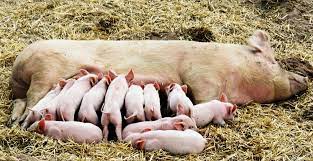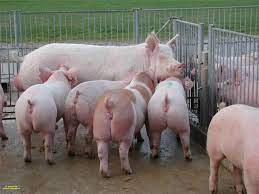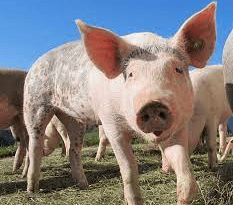Breeding Methods and Management of Swine
The success of swine production lies in the ability to reproduce good quality traits which form the basis for selection and breeding to achieve the objectives of production. The male as well as the female are important because each of them provide half of the inherited characteristics of the offspring.
Therefore, you as the stockman must accord good care for the breeding stock in farm animals. Swine production is affected by the occurrence of desirable traits in the breeding stock and the management of the animal to sustain such trait in the herd.
Improper handling or management may spell doom for such productive enterprise. Therefore, in this unit, we shall study the breeding/mating methods and management of the swine for breeding.
1. Herd Mating
This is a mating system that is uncontrolled and unplanned. All animals both males and females are allowed to mix freely with no restriction and no strict monitoring of the oestrus cycle of the female to dictate heat period.
2. Hand Mating
This is mating system which is controlled and planned. Here the farm manager gets to deliberately take the boar to the soar after selection from records and ensure they mate in an enclosure place. Hand mating has a higher labour requirement.
3. Selecting Boar for Service
Boars are selected following performance testing to ensure efficient performance of their offspring. The parameters usually considered include:
Fast growth rate than average.
Less back fat than average.
Eats less food than average.
High feed utilization due to low fat production.
Two equally sized and firmly suspended testicles and with good sexual libido.
Good body conformation, strong straight feet and good temperament.
Young boars that are newly brought to the herd must be properly nurtured to adapt to their new environment.
They should be dewormed, sprayed/dipped against ecto-parasites and exercised daily fitness, to enable him get used to his stock man as well as the sights and smells of the piggery. The boar should be fed well for continued growth, but should not be allowed to become fat and sluggish.
Selection of Sows for Breeding
When selecting the sows to be kept for breeding, the following point should be considered:
They should have at least 12 normal teats. In well-developed farms, they should have 14 teats, preferably seven on each side.
They should be the largest and the healthiest of the litter.\
They should have strong legs and walk well.
Their parents should be good breeding animals, capable of producing good sized litters at regular intervals.
Selecting the best females for breeding and giving them good housing and proper care are the important steps towards improved breeding practice.
Read Also : Different Breeds of Swine (Pigs)
Mating Conditions
Recent studies have indicated that boars mating on their own pens displayed lower levels of sexual behaviour than boars mating in the service pen. This resulted in a lower percentage of gilts being mated in the boar pen.
This has necessitated the use of a specifically designed service pen. A boar should not start serving until he is over eight months of age; and during the first two months of service, only twice per week.
Subsequently, he can be used for up to six services per week. Overworking a boar will reduce the quality of the sperm produced, leading to small litters and increased number of sows returning to service.
The standard recommendation is one boar to 20 sows/ gilts. Considerable exercise is necessary to prevent the development of leg weakness. It may be necessary to trim the boar’s feet regularly.
Management of Gilts/Sows

The major objective of gilt management should be to induce all replacement gilts to reach puberty as soon as possible after selection. This will allow the following objectives to be achieved:
Disposing of gilts which are not showing any breeding activity at an early stage.
Access to a pool of young, sexually-active gilts.
Gilts will be in their second heat or more at first mating there by increasing the first litter size.
Gilts and sows will tend to get too fat if they are not allowed enough exercise. A fat sow takes longer to come on heat and is more likely to crush her young piglets.
Sexual maturity occurs as early as 4 or 5 months, but the first service should not be until 8 months, when the weight should be 10-130 kg. A sow has a productive life of four to five years.
Pigs Breeding Cycle
Pigs like other animals will mate only when the female is on heat or during oestrus period. These are physiological changes that take place in the female which allow ovulation or shading of the egg for fertilization to take place in the presence of the male’s sperm.
The normal heat period lasts for three to five days; signs of heat are:
General restlessness.
Vulva turns red and swollen.
White mucus discharge.
Vulva less red and swollen, slimy mucous discharge.
Tendency to mount and be mounted.
Sow or gilt will stand still when pressure is applied to her back.
It is important to note that few of the signs above will be seen therefore it is best to put the sow with the boar for a short period every day when the heat is expected.
Always take the sow to the boar not the reverse as this is less upsetting for him. It is best to put them together just before feeding.
Let the boar serve her twice, with an interval of about 12 hours between services. If the sow does not conceive, she will return to heat in about 3-week time.
Read Also : Advantages and Disadvantages of Pig Farming
Management of Pregnant Sows
The gestation period is 114 days (three months, three weeks and three days). Pregnant sows should not be too crowded in their pens as this can cause abortion. A week before service, give the sow/gilt one kg of feed extra per day (standard is 2.5 kg/day).
Continue this for one week after service. During the last month of pregnancy give 0.5-1 kg extra feed per day, but decrease this gradually one week before farrowing, and provide plenty of water to help prevent congested gut during farrowing.
In preparation for farrowing, the farrowing pen should be kept clean and free form draughts. Disinfect the farrowing pen thoroughly and scrub crevices with insecticides to control mange and lice ten days before the commencement of farrowing.
Deworm the sow with dewormers that do not have adverse effect on feotus (that are not contraindicated) during pregnancy two weeks before the expected farrowing.
The sow should be moved to the farrowing pen four to seven days before farrowing and her body should be wash with soapy water and weak disinfectant to remove dirt and parasite eggs.
Provide plenty of straw, chopped into short lengths of about 10 cm to prevent the piglets being trapped in longer straw and being crushed by their mother. The first three days of life are the most critical for the piglets.
One day before farrowing the sow becomes restless and later milk can be squeezed out of the teats. She will begin to make a nest with straw. Use a well-designed farrowing pen (farrowing crate) to prevent the sow from accidentally crushing the piglets.
During farrowing, the sow/gilt will lie down and grunt. It will lift its hind legs as labour pains increases.
Generally, pigs have little difficulty farrowing and will farrow with little interference from the attendant. Farrowing normally takes four to six hours but some sows will take up to 18 hours or more.
When a piglet is born it will severe the naval cord and then walks round the sow’s hind legs to find the teats and within 45 minutes start suckling its first colostrum. The after birth (placenta) will either come out as the last piglet is born or immediately after that.
The placenta needs to be buried as soon as possible to prevent the sow/gilt from eating it, as this may open her appetite for her own piglets. Farmers should make sure their piglets have taken colostrums ‘the first milk’ which is rich in various nutrients and antibodies except iron and copper.
Young piglets from 10 days onwards should have a high protein diet available to them. This has to be fed in small creep (creep feeding) or area where the mother cannot eat the feed.
Weaning is the separation of young piglet from its mother with the aim of stopping them from suckling milk. This could take place between four to six weeks of their life. At this age, the piglets will eat feeds and fend for themselves.
By the eight to nine weeks of age the growing pig is over the stress of weaning, and its digestive system will be competent to deal with a range of protein and energy sources some 80% of the food used in a pig unit is consumed by the growing and finishing pigs, therefore the efficiency of food utilization during this phase is crucial factor affecting profitability.
In summary, proper management of each class of pigs on the farm is essential towards the profitability of the farm. The farmer must make every effort to ensure that the well-being and productivity of his animals are achieved.
Boars are selected following performance testing to ensure efficient performance of their offspring. This include, faster growth rate than average with less back fat than average. It should utilize its feed more efficiently and produce less fat, must have two equally sized and firmly suspended testicles and with good sexual libido.
A boar should not start serving until it is over eight months of age; and during the first two months of service, only twice per week. Subsequently, it can be used for up to six services per week.
Overworking a boar will reduce the quality of the sperm produced, leading to small litters and increased number of sows returning to service. The standard recommendation is one boar to 20 sows and gilts.
Piglets should be provided with warmth in the form of beddings made up of wood shavings or hay. In humid areas they should be put in a well-ventilated pen.
Read Also : Sources and Classification of Hazardous Waste









